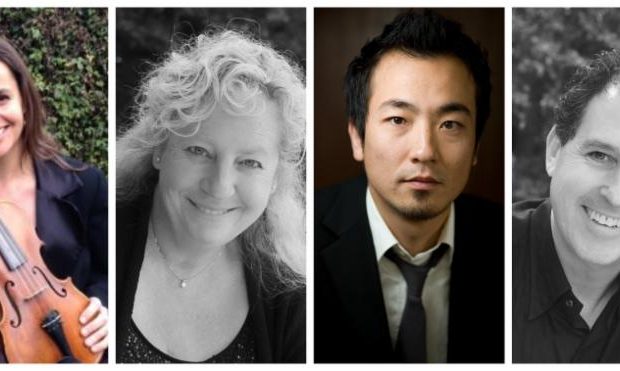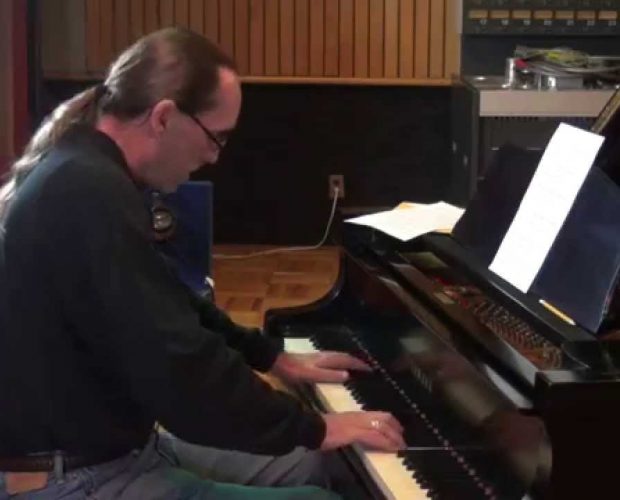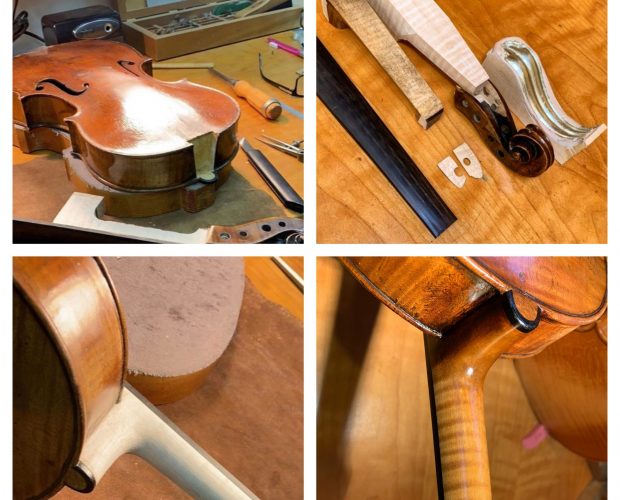Category: performance reviews
Vasks’s Piano Quartet received a much-deserved standing ovation from the audience.

The concert on Oct. 13 by the Ives Collective brought together three imaginative chamber pieces and fabulous musicians from around the world. Japanese pianist Keisuke Nakagoshi and violinist Hrabba Atladottir, a native of Iceland who studied in Berlin, joined Artistic Directors Stephen Harrison and Susan Freier in an astonishing performance featuring works by Zoltán Kodály, Latvian composer Pēteris Vasks, and Erich Korngold.
Hrabba Atladottir
The concert at Old First Church began with Kodály’s charming Intermezzo for String Trio. Described by Harrison as a “palate cleanser” for the rest of the afternoon, the piece lasted no more than six minutes and was an enjoyable and fitting opening. Over a bed of lively pizzicato, it alternated sweeping melodies and harmonies possibly inspired by the folk music of Hungary. These gestures suggested much of the rest of the program, especially in its plucked accompaniment, melodies that grow out of a handful of notes, and inspiration from beyond the concert hall. Probably written around 1905, this was the oldest work on the program yet fit surprisingly well with Vasks’s Piano Quartet, written nearly a century later.
The Piano Quartet is comprised of six movements that emerge from stunningly simple piano chords, and the musicians seemingly created intensity out of nothing. The work layers and repeats material endlessly, then moves between its vastly different movements without pause to sustain its intensity. “Danze” featured a rhythmic dance that grows more anxious and frantic between its pizzicato and call-and-response sections, nearing a vigorous fever pitch before being rescued by the deep cello melody of “Canti drammatici” (Dramatic Songs). Its close intervals and unhurried pace were reminiscent of Gregorian chant, with something intensely primal about the sound emanating from Harrison’s cello that captured one’s soul. “Quasi una passacaglia” continued in earnest, with a nearly ominous low-bellied piano melody and whispering strings, contrasted by bringing the strings and piano to stratospheric heights. The energetic fervor of the passacaglia dissolved with another hauntingly beautiful song from the cello that was then passed up through the strings, reaching a wonderfully optimistic climax. The spell was finally suspended with the “Postludio,” which highlighted violinist Atladottir’s impeccable intonation and purity of tone.
Keisuke Nakagoshi
Clearly the focal point of the afternoon, Vasks’s Piano Quartet received a much-deserved standing ovation from the audience. The sincerity and emotion of the performers was evident and created an enchanting experience. If this was an audience member’s first listen — certainly possible, as the work was composed in 2001 and is relatively unknown — then it surely became an instant favorite.
The concert finished with Korngold’s Suite for Two Violins, Cello, and Piano Left Hand, Op. 23, composed in 1930. A fascinating composer perhaps best known for his film scores, Korngold’s expressiveness and clear sense of melody were on display here. Nakagoshi’s virtuosic performance of the opening cadenza gave the impression of two hands and immediately established his preeminent role within the piece. Afterward, the Suite moved seamlessly between energetic and insistent themes, a romantic waltz, childlike and carefree ditties, to a triumphant final proclamation. Effervescent violin lines from Atladottir and Freier further enhanced the performance. The effect was a luminous and intriguing performance by a very unique group.
The Ives Collective programmed a fascinating series of works and managed to connect them with their sensitivity and superb playing. Atladottir and Nakagoshi brought brilliant virtuosity to their performances, turning these chamber pieces into an enchanting and intimate afternoon.
Catriona Barr is a musicologist and music teacher based in San Francisco. She holds a B.M. from Peabody Conservatory and a M.M. from King’s College, London.
Robin Sutherland, piano and Carlos Ortega, clarinet join Stephen Harrison for spring Salon

Please note that we have changed the Spring Salon program.
Sunday, April 14, 2019 at 4 PM
Program includes performance, discussion and champagne reception.
Moderated by Dr. Derek Katz
Johannes Brahms – Trio in A minor op.114
Just as Brahms declared he was retiring from composing, he heard the clarinetist Richard Mühlfeld, “absolutely the best wind-instrument player” he had ever encountered. Inspired by the variety of colors his “dear nightingale” could produce Brahms composed the Op.114 Trio and the Op.115 Quintet almost simultaneously – he called them his “twins”. These were works written with the sounds of particular performers in his ear – Mühlfeld on the clarinet, Robert Haussman on the cello. Thus, each instrument is given wonderful and varied opportunities for limitless expression.
Our Salon takes place in the intimacy and comfort of a beautiful, historic home in Palo Alto. We discuss and demonstrate what fascinates us about a particular piece, taking those who attend deeper into the process. We invite you to experience music in a setting that eliminates the boundaries between artist and listener. Together with our “house guests” we share ideas about musical interpretation and inspiration over champagne and appetizers.
The address will be provided at time of ticket purchase.
You did what to a 300-year-old viola?

A lot of our audience members are under the impression that the instruments we play are unaltered originals that have somehow survived the centuries. If only that were true!
Some years back Susan had the chance to purchase an old English viola (via our daughter’s English teacher, of all people). At the time Susan was teaching the girls how to play viola on a borrowed instrument – she didn’t own one. The paperwork was legit and the price reasonable, so after some consideration, Susan decided to buy the instrument. At the time Susan could barely read alto clef, but she adored that soulful viola sound. Fast forward a couple of decades and Susan is playing viola quite a bit.
At the Telluride Festival a couple of summers ago Susan showed the viola to Toby Appel, the virtuoso violist. He saw the potential of the instrument, but he told Susan that the neck was the widest he’d ever seen and that the length of the strings made the viola play bigger than it was. (Violas come in a lot of different sizes, but the standard measurement is the length of the body, not the neck.) And it had this very thick nut (the place where the strings meet the scroll) that appeared to be a clumsy attempt to rectify the string length. Toby suggested replacing the neck to make it far easier to play. (My guess is that strange nut was itself an early alteration to the original instrument.)
It took a while for Susan to come around to making the significant investment in replacing the neck, and she worried as she waited for the “new” instrument. Would her Thomas Smith sound the same, or would the process be as dangerous to the tone as giving a great singer a nose job?!
After a month with the rejuvenated Mr. Smith (who went to Salt Lake City and not Washington) Susan is thrilled to report that her viola plays more naturally and vividly than ever before. And she is thrilled to introduce the her “new” instrument in this set of Ives Collective concerts!
For our upcoming Ives Collective concert, Subject Matters, we have chosen three Preludes and Fugues composed or arranged from J.S. Bach by Mozart.

Why these three (out of the six published as K.404a)? All of the Preludes were actually composed by Mozart! The fugues are Mozart’s arrangements of fugues by Bach from the Well -Tempered Clavier. As you can see in the audio examples linked to below, Mozart changed the keys for all three works. As a violist himself Mozart understood that simply arranging the original three-voiced fugues in Bach’s keys would not result in the most resonant sound for the ensemble. His choices involve more open strings, making them far friendlier for players and their instruments.
Here are YouTube links to recordings of the original fugues by J.S. Bach which Mozart arranged for violin, viola and cello.
1) Fugue: Performance on piano with a graphic score (in Eb minor – D minor for the trio version):
2) Fugue: also a piano performance with score (In F# minor – G minor for the trio version):
3) Fugue: piano with score (in F# Major, not F as in the string trio):
How could I possibly forget P.D.Q. Bach’s (Peter Schickele’s) collaboration with the Oberlin Symphony when I was a student at the Oberlin Conservatory?
If my memory is correct, P.D.Q. swung down onto the Finney Chapel stage from the rafters, sliding quite a few feet on his stomach and coming to a halt a few feet from the back of the platform. What an entrance!! The concert included some P.D.Q. classics, but my most vivid memory is of his solo piano encore, “The High Karate Variations”. (High Karate was a pretty popular line of men’s fragrances at the time.) The first stand of cellos was just a few feet from the composer’s face and we wept with hysteria as he performed.
Later, I was introduced to the Schickele family through Andor Toth, the founder of the Stanford String Quartet who was friendly with Peter’s brother, David, an accomplished violist and documentary film maker. In fact, David invited us to join him in a memorial performance of the Schubert Cello Quintet to honor the passing of David and Peter’s father. At that time I had no idea that Peter Schickele was a serious composer.
What fun it has been to discover his more serious music through the charming and infectiously joyous Clarinet Quartet!
~ Stephen
The Ives Collective Rings Changes on Music of The First World War BY NICHOLAS JONES May 8, 2018
The First World War, which ended a century ago this November, maimed or destroyed many millions. From that devastation, strangely, “a terrible beauty [was] born,” as W. B. Yeats wrote in “Easter, 1916.” With new urgency, artists tried to imagine a poetry and a music that could respond truthfully to such overwhelming loss.
For some, art compensated for horror by summoning the values of a better past. Perhaps, as Rupert Brooke wrote, the graves of millions of dead soldiers could be seen as “some corner of a foreign field / That is forever England.” For others, such a dream had been long displaced by nightmare: the world had become a barren “Waste Land,” in T. S. Eliot’s words.
These contrasting aesthetics were powerfully portrayed by the Ives Collective in its concert of music associated with World War I, presented Sunday as part of the Old First Concert series in San Francisco. In four very different pieces, this committed and masterful ensemble gave complex insights into the struggle to make meaning out of the war that threatened to destroy meaning.
The afternoon began with Josef Suk’s 1914 string quartet, Meditation on the St. Wenceslas Chorale, based on a medieval tune beloved by Czech patriots. Meditation has a few elements of modernism, but for the most part employs a passionate late-Romantic aesthetic, rich in melody and emotionally rousing. One could hear how Czechs could see the war as an opportunity for liberation from their Austrian masters.
Edward Elgar’s Piano Quintet in A Minor, Op. 84 — which constituted the entire second half of the program — also looks back from the war to the past, in this case to the music of Schumann and Brahms. Though written in 1918, the quintet seems removed from the context of the trenches. It is perhaps better seen as Elgar’s own testament to the musical heritage of the Germanic nations that had sadly become England’s bitter enemy. In failing health but summoning up one of his final bursts of creative energy, Elgar, with his accustomed generosity of spirit, wants to give us hope even in the face of loss.
Like his Romantic predecessors, Elgar writes in a rich and melodic style that reflects a world of order: there is a clear three-movement structure; beautiful, full-bodied tunes (as one would expect from Elgar) are given ample motivic development; and the instruments converse with comfortable, humane gentility.
The Ives Collective recently expanded from a string quartet by incorporating other musicians including the fine pianist Keisuke Nakagoshi, currently pianist-in-residence at the San Francisco Conservatory of Music, who played with elegant balance and rich sonority. Elgar’s writing for the lower voices of the quartet allowed cellist Stephen Harrison, violist Jessica Chang, and second violinist Susan Freier a number of wonderfully expressive moments. First violinist Roy Malan led the many changes in tempo with clarity and musicality, though his higher notes did not carry in the relatively large space of Old First Church with the warmth of tone that the lower voices achieved. The group as a whole played with a tight sense of ensemble, supple in shifts of tempo and affect, while shaping spacious arcs of rise and fall.
The irony of “the war to end all wars” was featured in the first half of the program, particularly in a fine performance of the song cycle Ludlow and Teme by English poet and composer Ivor Gurney and based on poems by A. E. Housman. Gurney, a foot soldier in the trenches, knew the war firsthand, having suffered the effects of shell-shock and gassing. For the Ludlow cycle, he selected some of Housman’s bitterest poems and set them with a telling sense of contrast — between predictability and randomness, fertility and waste, countryside and battlefield, life and death.
For the Gurney cycle, the quintet was joined by tenor Brian Thorsett, whose powerful voice encompassed these ironic contrasts with command and sensitivity. Especially moving was “On the idle hill of summer,” which begins with a pastoral lyric “sleepy with the flow of streams” but morphs swiftly into a nightmare of “calling bugles” and “screaming fife[s].” Befitting the poem, Gurney’s music pushes the ensemble beyond gracefulness, and both Thorsett and the quintet rose to the challenge with chilling effect.
Thorsett also sang “Elegiac Sonnet” by Arthur Bliss, a memorial to a pianist who committed suicide in 1953. While Bliss’s short and passionate outburst (on a poem by C. Day Lewis) displays the dystopia of a world overwhelmed by loss, its connection with the First World War seemed tentative, and neither the poem text nor the music matched the quality of Gurney or Housman.
Overall, this program of seldom-heard pieces, pushed into a fascinating proximity, made for an intellectually stimulating and musically satisfying afternoon.
2015-16 Ives Collective Concert Series

FALL COLLECTIVE
Roy Malan, violin; Susan Freier, violin/viola; Paul Yarborough, viola: Stephen Harrison, cello; Keisuke Nakagoshi, piano.
Program: Great Romantic Works
Felix Mendelssohn:, Piano Trio in C minor, Op.66
Robert Schumann::, Piano Quartet in Eb Major, Op.47
Ernst von Dohnányi:, Piano Quintet No.2 in Eb minor, Op.26
First Congregational Church
Palo Alto, CA
Sunday, October 4, 2015, 3PM*
*Please note, this is an afternoon concert.

WINTER COLLECTIVE
Susan Freier, violin; Stephen Harrison, cello; Elizabeth Schumann, piano; Peter Joseff, clarinet
Program: The End of Time
Olivier Messiaen: The Quartet for the End of Time
Paul Hindemith: Quartet
St. Mark’s Episcopal Church
Palo Alto, CA
Friday, January 29, 2016, 8PM
Old First Church
San Francisco, CA
Sunday, January 31, 2016, 4PM
*Please note, this is an afternoon concert.

SPRING COLLECTIVE
Roy Malan, violin; Susan Freier, violin; Stephen Harrison, cello: Laura Dahl, piano; Ken Goodson, baritone.
Program: A Samuel Barber Celebration
Samuel Barber
String Quartet, Op 11
Cello Sonata, Op. 6
Dover Beach, Op. 3
Serenade for String Quartet, Op.1
3 Barber Songs: The texts of James Joyce’s Chamber Music (1907)
“Rain Has Fallen” “Sleep Now” “I Hear an Army”
St. Mark’s Episcopal Church
Palo Alto, CA
Saturday, April 23, 2016* 8PM
*Note this is a Saturday evening performance.
Old First Church
San Francisco, CA
Sunday, April 24 2016, 4PM
Our Flex Pass subscribers may use their tickets at Old First Church in San Francisco or at St. Mark’s Church in Palo Alto.
All programs, artists and policies of the Ives Collective are subject to change without notice.
IVES QUARTET SEASON 16
2014-2015
HOME CONCERT SERIES
FALL
St. Mark’s: Friday, November 7, 2014, 8PM
Old First Concerts: Friday, November 14, 2014, 8PM
William Bolcom: Three Rags (Poltergeist; Graceful Ghost; Incineratorag)
Quincy Porter: String Quartet No. 9
Antonin Dvorak: String Quintet No. 3, Op. 97, Guest violist, Jenny Douglass
WINTER
St. Mark’s: Friday 27, 2015, 8PM
Old First Concerts: Sunday, March 1, 2015, 4PM
Joseph Haydn: Two movements for String Quartet in D Minor, Op. 103
George Rochberg: String Quartet No. 6, selections
Franz Schubert: String Quartet No. 15 in G Major, D. 887
SPRING
St. Mark’s: Friday, April 24, 2015, 8PM
Old First Concerts: Sunday, April 26, 2015, 4PM
Elinor Armer: Piano Quintet
Darius Milhaud: String Quartet No. 1, Op. 5
César Franck: Piano Quintet in F minor
Guest pianist, Mack McCray
Our Flex Pass subscribers may use their tickets at Old First Church in San Francisco or at St. Mark’s Church in Palo Alto. Unfortunately, we are no longer performing at Le Petit Trianon in San Jose.
MUSIC IN CONTEXT
Palo Alto Salon Series
Sundays at 4PM. Limited seating.
Tickets available by phone only: 650-224-7849
Please join us:
October 5, 2014
March 15, 2015
May 17, 2015
WINTER CONCERT SERIES: Each an Experiment
St. Mark’s: Friday, February 21, 8PM
Old First Concerts: Sunday, February 23, 2014, 4PM
- Wolfgang Amadeus Mozart: String Quartet in E-flat major, K.428
- Henry Cowell: String Quartet No. 3, Mosaic
- Felix Mendelssohn: String Quartet in F minor, Op. 80
The searching Mozart, the experimenting Cowell and the grieving Mendelssohn make up the winter program. In emulation of Haydn, Mozart seeks a more complex quartet style while Cowell’s Mosaic is just that—a free-form composition whose movements can be played in any order. Mendelssohn’s last major work before his death, the F minor quartet, is subtitled “Requiem for Fanny” in memory of his beloved sister.
